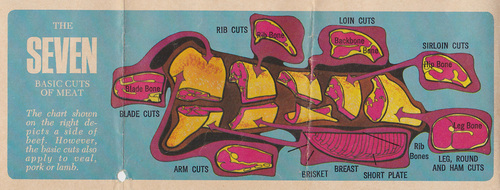- Home
- Special Helps
- Photo Guides
- Menu Ideas & Special Occasions
- Meal Ideas without Recipes
- Creative Food Ideas
- Appetizers
- Beverages
- Biscuits & Breads
- Breakfast
- Preserved Foods & Cheese
- Desserts
- Main Courses
- Chinese
- Mexican
- Sandwiches
- Salads & Salad Dressings
- Sauces & Gravies
- Side Dishes
- Soups, Chili & Stews
- Miscellaneous
- chickenandeggcookbook.com
Dry Heat Methods:
* Oven Roasting: for large tender cuts
- season with salt and pepper if desired
- place meat, fat side up, on rack in open shallow roasting pan
- insert a meat thermometer so that the bulb is in the center of the largest muscle
- add no water and do not cover
- roast according to roasting tables
* Broiling: best suited for tender steaks and ground beef at least 1- inch thick
- set the oven regulator for broiling
- place the beef on broiler pan at least 3-6 inches for the heat. Remember that is you are broiling, you should place a thick cut of meat further away from the heat than a thinner cut to assure proper cooking
- broil until top side is brown
- season top side with salt and pepper if desired
- turn and brown other side
- season to taste and serve at once
* Panbroiling - for tender cuts 1-inch thick or less
- place meat in a open skillet or on a griddle. The pan may be rubbed with a little beef fat, or sprinkled with a thin layer of salt, the prevent sticking
- do not add fat or water and do not cover
- cook slowly, turning occasionally
- pour off or remove fat as it accumulates
- brown meat on both sides
- do not overcook, season as desired and serve at once
* Panfrying - similar to panbroiling
- brown meat on both sides in a hot skillet using a small amount of fat
- season with salt and pepper as desired
- do not cover the meat or add liquid
- cook at moderate temperature, turning occasionally, until done
- remove from pan and serve at once
Moist Heat Methods:
* Braising - suitable for less ender cuts of beef (also called Pot Roasting)
- brown meat slowly on all sides in a heavy utensil (the beef may be rolled or dipped in flour first)
- season as desired
- add a small amount of liquid if necessary
- cover tightly
- cook at a low temperature until tender
- make a sauce or gravy from the liquid in the pot, if desired
* Simmering - requires more water than other methods because the beef needs longer cooking and more moisture to make it fork tender
- brown meat on all sides, if desired
- cover meat with water or stock
- season as desired
- cover pot and simmer (do not boil) until tender
- if the meat is to be served cold, let it cool and then chill in the stock in which it was cooked
-when vegetables are to be cooked with the meat as in boiled dinners, add them whole or in pieces, just long enough before the meat is tender, to cook them.

